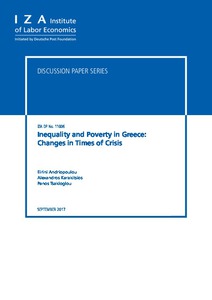Inequality and poverty in Greece: changes in times of crisis
"The Greek crisis was the deepest and longest ever recorded in an OECD country in the postwar period. Output declined by over a quarter and disposable income by more than 40%, while the unemployment rate exceeded 27%. The paper explores the effects of the crisis on the level and the structure o...
| Main Authors: | , , |
|---|---|
| Institution: | ETUI-European Trade Union Institute |
| Format: | TEXT |
| Language: | English |
| Published: |
Bonn
2017
IZA |
| Subjects: | |
| Online Access: | https://www.labourline.org/KENTIKA-19286430124910046129-inequality-and-poverty-in-Gree.htm |
| Summary: | "The Greek crisis was the deepest and longest ever recorded in an OECD country in the postwar period. Output declined by over a quarter and disposable income by more than 40%, while the unemployment rate exceeded 27%. The paper explores the effects of the crisis on the level and the structure of aggregate inequality and poverty using the data of EU-SILC for the period 2007–2014. The results show that inequality rose but the magnitude of the change varies across indices. The recorded increases are larger when the indices used are relatively more sensitive to changes close to the bottom of the income distribution. Unlike claims often made in the public discourse, the elderly improved their relative position in the income distribution while there was substantial deterioration in the relative position of the enlarged group of the unemployed. The contribution of disparities between educational groups to aggregate inequality declined while that of disparities between socio-economic groups rose. All poverty indicators suggest that poverty increased substantially, especially when "anchored" poverty lines are used. Substantial changes are observed regarding the structure of poverty. Despite an increase in the population share of households headed by pensioners, their contribution to aggregate poverty declined considerably, with a corresponding increase in the contribution of households headed by unemployed persons. The changes are starker when distribution-sensitive poverty indices are utilized." |
|---|---|
| Physical Description: | 28 p. Digital |

